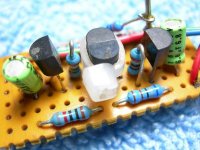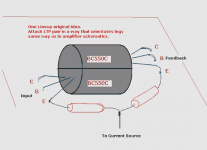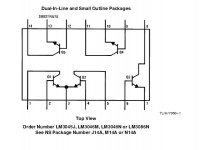in the past most japanese manufacturers designed amplifiers with ltp stage in a dual case and probably with a matched pair .
QUESTION:
is this done for thermal tracking reasons???
is there any other reasons????
if so what is the beneffit of thermal tracking in this particular LTP application ????
after all that
why today's designers no longer design with this kind of transistors????
if for a minute we presume that these transistors( dual cased ) are either obsolete or too expensive why not desingn with bc 559 for example but in such a layout design that both transistors can have mechanical joint with some glue for example.
thanks sakis
QUESTION:
is this done for thermal tracking reasons???
is there any other reasons????
if so what is the beneffit of thermal tracking in this particular LTP application ????
after all that
why today's designers no longer design with this kind of transistors????
if for a minute we presume that these transistors( dual cased ) are either obsolete or too expensive why not desingn with bc 559 for example but in such a layout design that both transistors can have mechanical joint with some glue for example.
thanks sakis
sakis said:
QUESTION:
is this done for thermal tracking reasons???
Yes!
if so what is the beneffit of thermal tracking in this particular LTP application ????
Less offset voltage, over the variable temperature range
why not desingn with bc 559 for example but in such a layout design that both transistors can have mechanical joint with some glue for example.
Yes, you can do that...
Re: Re: Ltp Dual Case
BC550C, BC560C (45 V), works no problems in 2 x 22 VDC supply, for output stage.
BC549C, BC559C (30 V), works no problems in 2 x 15 VDC supply
We are many that uses these lownoise hifi transistors for LTP pairs.
It is recommended to use C versions,
as higher gain is a plus and also reduces base input current (bias).
Less bias current makes lower input noise from resistors
and gives less DC-offset problems at output.
As these transistors are very very cheap, you can buy many.
Then you test until you find good matching pairs.
Usually, if your buy is from same batch, same bigpack (made by a specific machine on a specific day),
should be easy to find matching pairs.
This is why is much much better to buy 100 once,
than buy 10 here and 10 then and next 20 of those BC560C / BC550C.
You can measure and match V b-e,
at the specific Current level
(usually range: 0.4-2.5 milliAmpere is ideal for these transistors)
and Collector-Emitter voltage of your circuit.
At least this is what I do.
Then, if you put each pair Body-to-Body contact,
you have made close to a 'perfect' dual transistor.
See my attachment, what I use instead of glue (some glue will attack plastic!).
If you wish, you can add silicon thermal grease compound
http://en.wikipedia.org/wiki/Thermal_grease
but I do not bother with it. Just good tight mechanical pressure works good enough for me.
Regards, lineup
sakis said:in the past most japanese manufacturers designed amplifiers
with ltp stage in a dual case and probably with a matched pair .
-------
if for a minute we presume that these transistors( dual cased ) are either obsolete or too expensive
why not desingn with bc 559 for example but in such a layout design
that both transistors can have mechanical joint with some glue for example.
Tube_Dude said:
Yes, you can do that...
BC550C, BC560C (45 V), works no problems in 2 x 22 VDC supply, for output stage.
BC549C, BC559C (30 V), works no problems in 2 x 15 VDC supply
We are many that uses these lownoise hifi transistors for LTP pairs.
It is recommended to use C versions,
as higher gain is a plus and also reduces base input current (bias).
Less bias current makes lower input noise from resistors
and gives less DC-offset problems at output.
As these transistors are very very cheap, you can buy many.
Then you test until you find good matching pairs.
Usually, if your buy is from same batch, same bigpack (made by a specific machine on a specific day),
should be easy to find matching pairs.
This is why is much much better to buy 100 once,
than buy 10 here and 10 then and next 20 of those BC560C / BC550C.
You can measure and match V b-e,
at the specific Current level
(usually range: 0.4-2.5 milliAmpere is ideal for these transistors)
and Collector-Emitter voltage of your circuit.
At least this is what I do.
Then, if you put each pair Body-to-Body contact,
you have made close to a 'perfect' dual transistor.
See my attachment, what I use instead of glue (some glue will attack plastic!).
If you wish, you can add silicon thermal grease compound
http://en.wikipedia.org/wiki/Thermal_grease
but I do not bother with it. Just good tight mechanical pressure works good enough for me.
Regards, lineup
Attachments
😉
Hi!
This is another of my original audio ideas.
When I use this way to attach and mount one LTP, long tailed pair,
I will get the pcb layout to correspond to most amp schematics.
You put one BC550C with legs to LEFT and the other with legs to RIGHT.
C, B and E will be logically situated.
A matched pair in body contact, for good thermal tracking, is supposed.
Regards 🙂 Lineup
Hi!
This is another of my original audio ideas.
When I use this way to attach and mount one LTP, long tailed pair,
I will get the pcb layout to correspond to most amp schematics.
You put one BC550C with legs to LEFT and the other with legs to RIGHT.
C, B and E will be logically situated.
A matched pair in body contact, for good thermal tracking, is supposed.
Regards 🙂 Lineup
Attachments
I think many dual transitors use a common die and so their characteristics are very closely matched in addition to the thermal tracking advantage.
lineup said:😉
Hi!
This is another of my original audio ideas.
When I use this way to attach and mount one LTP, long tailed pair,
I will get the pcb layout to correspond to most amp schematics.
Regards 🙂 Lineup
Not so good idea ... you will get an asymmetrically temperature gradient
roender said:
Not so good idea ... you will get an asymmetrically temperature gradient
yes, true, a bit 🙂
But if you test it in real life, you will see it is no big problem.
There are many theoretical assumptions, ungrounded fears
.. that are of no deal when it comes to practical reality.
( just read some of atom level, cryonic resistors and 0.01 nV noise
academical discussions in blowtorch, for example.
Between these "who's best boy in town & knows it all" -posts,
the John Curl thread gives some good useful knowledge )
One other feature I did not mention:
you get both collectors at V+ side and both emittors at V- side.
So most of the time you can easily make short tracks for supply.
regards, lineup
lineup said:
One other feature I did not mention:
you get both collectors at V+ side and both emittors at V- side.
So most of the time you can easily make short tracks for supply.
regards, lineup
Yes and no ... one bjt will have longer pin conections
roender said:
Yes and no ... one bjt will have longer pin conections
This is no problem for me.
As I use hardwiring, when doing 'critical' circuits.
for normal audio, roender, I can asure you,
you won't be able to measure or hear anything
by using the construction in my last picture.
Regards 🙂 having no fears & anxiety, when doing audio, Practically
I've wondered...
If you also add a piece of metal strip (heatsink ) between the two joined/coupled LTP transistors (with grease), would the pair also be less inclined or maybe slower to change temperature, thus help minimize offset and keep their thermal dynamics better controlled?
..Todd
If you also add a piece of metal strip (heatsink ) between the two joined/coupled LTP transistors (with grease), would the pair also be less inclined or maybe slower to change temperature, thus help minimize offset and keep their thermal dynamics better controlled?
..Todd
taj said:I've wondered...
If you also add a piece of metal strip (heatsink ) between the two joined/coupled LTP transistors (with grease), would the pair also be less inclined or maybe slower to change temperature, thus help minimize offset and keep their thermal dynamics better controlled?
..Todd
Better stilll,
is to do like I have seen in hifi amplifiers
-> wrap both transistors with a copper-housing
elektor projects have used:
copper tubing (usually for transporting water in houses)
with an inner diameter close to the diameter of 2 TO-92
you cut like 8-10 mm of such a copper tube
then you slit the tub open and put around those transistors
and press the copper to 'grip tight' the transistors
I could show a drawing of it, if you need.
There might even be pictures around of this way.
-------
Edit:
I found an image, in a very good article!
Regards 🙂 lineup

Offsetting an audio amplifier
Differences between the two halves of a differential
http://www.angelfire.com/sd/paulkemble/sound7e.html
.
- Status
- Not open for further replies.
- Home
- Amplifiers
- Solid State
- Ltp Dual Case


